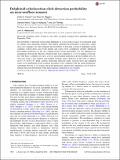Files in this item
Delphinid echolocation click detection probability on near-seafloor sensors
Item metadata
| dc.contributor.author | Frasier, Kaitlin E. | |
| dc.contributor.author | Wiggins, Sean M. | |
| dc.contributor.author | Harris, Danielle | |
| dc.contributor.author | Marques, Tiago A. | |
| dc.contributor.author | Thomas, Len | |
| dc.contributor.author | Hildebrand, John A. | |
| dc.date.accessioned | 2017-03-23T00:33:25Z | |
| dc.date.available | 2017-03-23T00:33:25Z | |
| dc.date.issued | 2016-09 | |
| dc.identifier | 246546571 | |
| dc.identifier | 36760164-e9d2-4df0-bddb-e909233fa4fa | |
| dc.identifier | 84988735435 | |
| dc.identifier | 000386932500051 | |
| dc.identifier.citation | Frasier , K E , Wiggins , S M , Harris , D , Marques , T A , Thomas , L & Hildebrand , J A 2016 , ' Delphinid echolocation click detection probability on near-seafloor sensors ' , Journal of the Acoustical Society of America , vol. 140 , no. 3 , pp. 1918-1930 . https://doi.org/10.1121/1.4962279 | en |
| dc.identifier.issn | 0001-4966 | |
| dc.identifier.other | ORCID: /0000-0002-7436-067X/work/29591651 | |
| dc.identifier.other | ORCID: /0000-0002-2581-1972/work/56861266 | |
| dc.identifier.other | ORCID: /0000-0003-1447-1420/work/61370035 | |
| dc.identifier.uri | https://hdl.handle.net/10023/10512 | |
| dc.description | Funding for HARP data collection and analysis was provided by the Natural Resource Damage Assessment partners (20105138) and the Center for the Integrated Modeling and Analysis of the Gulf Ecosystem (C-IMAGE) Consortium of the BP/Gulf of Mexico Research Initiative (SA 12-10/GoMRI-007). The analyses and opinions expressed are those of the authors and not necessarily those of the funding entities. This research was made possible by a grant from The Gulf of Mexico Research Initiative/C-IMAGE II. | en |
| dc.description.abstract | The probability of detecting echolocating delphinids on a near-seafloor sensor was estimated using two Monte Carlo simulation methods. One method estimated the probability of detecting a single click (cue counting); the other estimated the probability of detecting a group of delphinids (group counting). Echolocation click beam pattern and source level assumptions strongly influenced detectability predictions by the cue counting model. Group detectability was also influenced by assumptions about group behaviors. Model results were compared to in situ recordings of encounters with Risso's dolphin (Grampus griseus) and presumed pantropical spotted dolphin (Stenella attenuata) from a near-seafloor four-channel tracking sensor deployed in the Gulf of Mexico (25.537°N 84.632°W, depth 1220 m). Horizontal detection range, received level and estimated source level distributions from localized encounters were compared with the model predictions. Agreement between in situ results and model predictions suggests that simulations can be used to estimate detection probabilities when direct distance estimation is not available. | |
| dc.format.extent | 13 | |
| dc.format.extent | 2072553 | |
| dc.language.iso | eng | |
| dc.relation.ispartof | Journal of the Acoustical Society of America | en |
| dc.subject | GC Oceanography | en |
| dc.subject | Arts and Humanities (miscellaneous) | en |
| dc.subject | Acoustics and Ultrasonics | en |
| dc.subject | DAS | en |
| dc.subject.lcc | GC | en |
| dc.title | Delphinid echolocation click detection probability on near-seafloor sensors | en |
| dc.type | Journal article | en |
| dc.contributor.institution | University of St Andrews. School of Mathematics and Statistics | en |
| dc.contributor.institution | University of St Andrews. Sea Mammal Research Unit | en |
| dc.contributor.institution | University of St Andrews. Centre for Research into Ecological & Environmental Modelling | en |
| dc.contributor.institution | University of St Andrews. Scottish Oceans Institute | en |
| dc.contributor.institution | University of St Andrews. Statistics | en |
| dc.contributor.institution | University of St Andrews. Marine Alliance for Science & Technology Scotland | en |
| dc.identifier.doi | https://doi.org/10.1121/1.4962279 | |
| dc.description.status | Peer reviewed | en |
| dc.date.embargoedUntil | 2017-03-22 |
This item appears in the following Collection(s)
Items in the St Andrews Research Repository are protected by copyright, with all rights reserved, unless otherwise indicated.

